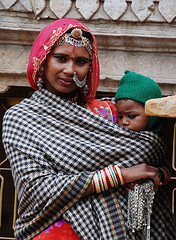The abundance of jewelry in Indian culture has required the use of piercing to secure some important ornaments. The ears of women and sometimes men and the noses of men are the most common areas for piercing. Practiced since ancient times, piercing continues to be an important part of Indian culture.
In India the ears are often pierced in multiple places and elaborate earrings are hung from the holes. The placement of the piercing is determined by religious, regional, or ethnic customs. In some areas in southern India, for example, the ear lobes of female infants used to be pierced and stretched so that by the time she reached thirteen years old, the girl's earlobes hung almost to her shoulders. This practice signified wealth and virtue among women from ancient times, and females without stretched lobes were shunned or considered prostitutes. This particular custom began to disappear in the nineteenth century as Christian missionaries converted people in these areas.
A woman displays her traditional Indian nose piercings. The placement of piercings are often determined by religious, regional, or ethnic customs.
 Piercing the nose has special significance in Indian culture. In rural areas female infants' noses are pierced to protect them from evil spirits and illness. Nose ornaments have been used in India since at least 1250 C.E. , when Muslims were invading the area from central Asia and Persia (present-day Iran), where use of nose ornaments was customary. The nose ring has since become very important in Indian culture as a symbol of a woman's marital status. Women wear a nose ring only while their husband is living. Nose ornaments include studs pierced through the side of the nose, rings threaded through the septum (or central part of the nose), and large hoops adorned with jewels hooked through one nostril and supported by a chain secured in the hair or to headwear.
Piercing the nose has special significance in Indian culture. In rural areas female infants' noses are pierced to protect them from evil spirits and illness. Nose ornaments have been used in India since at least 1250 C.E. , when Muslims were invading the area from central Asia and Persia (present-day Iran), where use of nose ornaments was customary. The nose ring has since become very important in Indian culture as a symbol of a woman's marital status. Women wear a nose ring only while their husband is living. Nose ornaments include studs pierced through the side of the nose, rings threaded through the septum (or central part of the nose), and large hoops adorned with jewels hooked through one nostril and supported by a chain secured in the hair or to headwear.

No comments:
Post a Comment